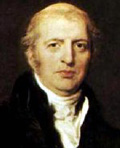Robert Jenkinson, 2nd Earl of Liverpool
|
|

| |
| Period in Office: | June, 1812 - April, 1827 |
| PM Predecessor: | Spencer Perceval |
| PM Successor: | George Canning |
| Date of Birth: | 7 June 1770 |
| Place of Birth: | London |
| Date of Death: | 4 December 1828 |
| Place of Death: | Kingston upon Thames, Surrey |
| Political Party: | Tory |
Robert Banks Jenkinson, 2nd Earl of Liverpool (June 7, 1770 - December 4, 1828) was a British statesman, Prime Minister of the United Kingdom from 1812 to 1827.
The son of George III's close adviser Charles Jenkinson, 1st Earl of Liverpool, Robert Jenkinson was educated at Charterhouse School and Christ's College, Cambridge. He entered the House of Commons in 1790 and rose quickly through the Tory ranks. He served as a member of the Board of Control for India (1793-1796), and as Master of the Mint (1799-1801). He was Lord Hawkesbury from 1796 to 1808, before succeeding to his father's title. In Henry Addington's government Hawkesbury entered the cabinet as Secretary of State for Foreign Affairs, in which capacity he negotiated the Treaty of Amiens with France.
In later governments, Hawkesbury continued to serve in important cabinet positions - as Home Secretary in Pitt's second government and the Duke of Portland's second government, and then as Secretary of State for War and the Colonies in Perceval's government.
When Perceval was assassinated in May, 1812, Lord Liverpool succeeded him as prime minister. Liverpool's ministry was a long and eventful one - it saw Britain's victory in the Napoleonic Wars, the Congress of Vienna, and the eventful early years of peace which followed. Liverpool, aware that his abilities were no more than moderate, generally stayed in the background, letting more brilliant subordinates like Lord Castlereagh, George Canning, the Duke of Wellington, Robert Peel, and William Huskisson, all of whom served under him, take leading parts. Nevertheless, Liverpool was himself a skilful politician, and held together the liberal and reactionary wings of the Tory party, which his successor, Canning, failed to do. Liverpool retired in 1827.
Lord Liverpool's Administration, June 1812 - April 1827
- Lord Liverpool - First Lord of the Treasury and Leader of the House of Lords
- Lord Eldon - Lord Chancellor
- Lord Harrowby - Lord President of the Council
- Lord Westmorland - Lord Privy Seal
- Lord Sidmouth - Secretary of State for the Home Department
- Lord Castlereagh (Lord Londonderry after 1821) - Secretary of State for Foreign Affairs and Leader of the House of Commons
- Lord Bathurst - Secretary of State for War and the Colonies
- Lord Melville - First Lord of the Admiralty
- Nicholas Vansittart - Chancellor of the Exchequer
- Lord Mulgrave - Master-General of the Ordnance
- Lord Buckinghamshire - President of the Board of Control
- Charles Bathurst - Chancellor of the Duchy of Lancaster
- Lord Camden - minister without portfolio
Changes
- late 1812 - Lord Camden leaves the Cabinet.
- September, 1814 - William Wellesley-Pole, the Master of the Mint, enters the Cabinet.
- February, 1816 - George Canning succeeds Lord Buckinghamshire at the Board of Control
- January, 1818 - Frederick John Robinson, the President of the Board of Trade, enters the Cabinet.
- January, 1819 - The Duke of Wellington succeeds Lord Mulgrave as Master-General of the Ordnance. Lord Mulgrave becomes minister without portfolio.
- 1820 - Lord Mulgrave leaves the cabinet.
- January, 1821 - Charles Bathurst succeeds Canning as President of the Board of Control, remaining also at the Duchy of Lancaster.
- January, 1822 - Robert Peel succeeds Lord Sidmouth as Home Secretary
- February, 1822 - Charles Williams Wynn succeeds Charles Bathurst at the Board of Control. Bathurst remains at the Duchy of Lancaster and in the Cabinet.
- September, 1822 - Following the suicide of Lord Londonderry, George Canning becomes Foreign Secretary and Leader of the House of Commons.
- January, 1823 - Vansittart, elevated to the peerage as Lord Bexley, succeeds Charles Bathurst as Chancellor of the Duchy of Lancaster. F.J. Robinson succeeds Vansittart as Chancellor of the Exchequer. He is succeeded at the Board of Trade by William Huskisson.
- 1823 - Lord Maryborough, the Master of the Mint, leaves the Cabinet. His successor in the office is not a Cabinet member.
Categories: British Prime Ministers | Secretaries of State for Foreign Affairs (UK) | Secretaries of State for the Home Department (UK) | Secretaries of State for War and the Colonies (UK) | Earls in the Peerage of Great Britain | Knights of the Garter | 1770 births | 1828 deaths | Lords Warden of the Cinque Ports
